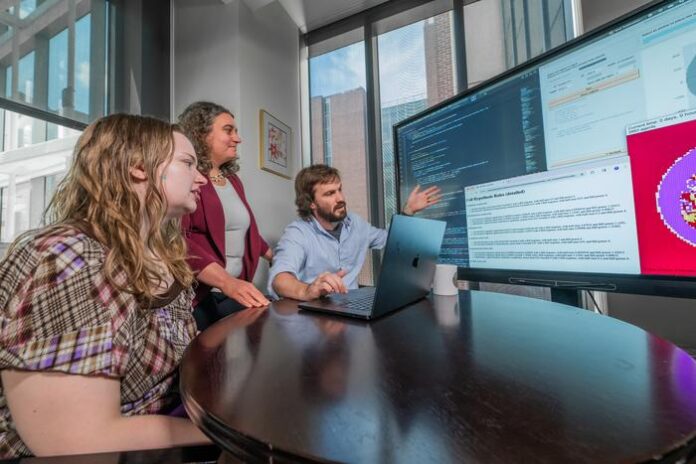
Researchers from Indiana University and the University of Maryland School of Medicine have introduced a groundbreaking method to predict cell activity in tissues over time. This innovative approach mirrors weather forecasting models, allowing scientists to anticipate changes in cell behavior, including interactions that could promote cancer growth.
The new software developed by the team merges genomics technologies with computational modeling. It utilizes a plain-language “hypothesis grammar,” which serves as a bridge connecting biological systems with computational models. This unique framework simulates cellular actions within tissues, enabling virtual experiments that explore how cancer interacts with its environment and how the brain develops.
The findings were published in the journal Cell, detailing virtual experiments that assess cancer’s response to surrounding cells and the developmental layering of the brain. This work is a product of a collaborative project involving multiple laboratories, focusing on the intersection of software development and clinical research.
Daniel Bergman, PhD, a scientist at the Institute for Genome Sciences (IGS) and Assistant Professor of Pharmacology and Physiology at UMSOM, emphasized the study’s potential impact. “Our new ‘grammar’ facilitates communication between biology and code, and also encourages collaboration across different scientific disciplines,” he stated. The published paper is titled “Human interpretable grammar encodes multicellular systems biology models to democratize virtual cell laboratories.”
The researchers concluded that their methodology “bridges biological, clinical, and systems biology research for mathematical modeling at scale.” They highlight the complex ecosystems formed by cells, which evolve dynamically over time. Despite advancements in single-cell and spatial multiomics technologies that quantify individual cell characteristics, predicting their evolution remains a significant challenge.
“Generating temporally resolved multicellular predictions remains an open computational challenge,” the team noted. While current bioinformatics techniques can forecast cellular trajectories, they often fall short when accounting for intricate changes across multicellular networks over time. The researchers argue that more sophisticated computational tools are essential for forecasting emergent behaviors in these systems.
Jeanette Johnson, PhD, a postdoctoral fellow at IGS, remarked on the limitations of traditional biomedical research. “Standard methods provide a snapshot of cellular ecosystems rather than illustrating how diseases like cancer arise from cell communication,” she explained. The immune system’s role in cancer progression is highly individualized, complicating predictions based on human data.
Leading the development of the new grammar, Paul Macklin, PhD, Professor of Intelligence Systems Engineering at Indiana University, described how it employs natural language statements to formulate mathematical models. This allows scientists to articulate cell behavior in simple English sentences, creating digital representations of complex biological systems.
“This enables systematic integration of biological knowledge and multiomics data to generate in silico models, allowing virtual ‘thought experiments’ that enhance our understanding of multicellular systems,” the authors stated. Previously, creating basic models required intricate coding skills, but this new grammar simplifies the process to a more accessible format.
Bergman and his colleagues integrated this grammar with genomic data from real patient samples to study both breast and pancreatic cancer. In their breast cancer model, they examined scenarios where the immune system failed to inhibit tumor growth, leading to increased invasion and spread. They also adapted their framework to simulate a real-world immunotherapy clinical trial for pancreatic cancer.
Using genomic data from untreated pancreatic cancer tissue, the model predicted that each virtual “patient” would respond differently to immunotherapy, underscoring the significance of cellular ecosystems in precision oncology. Pancreatic cancer, known for its challenging treatment landscape, often contains dense clusters of non-cancerous cells known as fibroblasts. The researchers utilized advanced spatial genomics technology to illustrate the communication pathways between fibroblasts and tumor cells, tracking the progression of pancreatic tumors through patient-derived tissue.
The newly developed grammar is open-source, designed to benefit the wider scientific community. “By making this tool accessible, we are paving the way to standardize models and enhance their acceptance,” Bergman added. To demonstrate its versatility, Genevieve Stein-O’Brien, PhD, from Johns Hopkins School of Medicine, led efforts to apply this approach in neuroscience, simulating brain development layers.
The authors assert that this new conceptual framework for specifying cell behavior hypotheses can systematize how scientists understand cellular interactions in tissue ecosystems. They presented a variety of models that extend from cancer biology to neurodevelopment.
Johnson expressed her enthusiasm for the models, stating they can integrate both laboratory and human genomic data. “This framework provides a sandbox to test our hypotheses regarding the immune system’s function over time, with minimal costs or risks to patients.”
Co-lead author Elana J. Fertig, PhD, Director of IGS and Professor of Medicine and Epidemiology at UMSOM, highlighted the significance of this research. “The principles we used to predict weather can also apply to biological systems, enabling predictive models in cancer,” she remarked. Fertig described the research as a “tapestry of team science,” with additional validation sourced from collaborations with clinical partners at Johns Hopkins University and Oregon Health Sciences University.
Mark T. Gladwin, MD, Vice President for Medical Affairs at the University of Maryland, noted the broader implications of this work. “This framework allows researchers to create computerized simulations of laboratory and clinical trials, predicting therapy effects on patients,” he stated. “This has significant applications for digital twins and virtual clinical trials in cancer and beyond.”
As the team looks to the future, they aim to extend this computational modeling framework to clinical applications, potentially transforming how cancer and other diseases are understood and treated.







